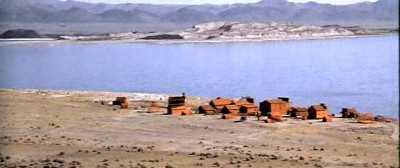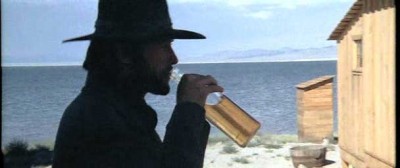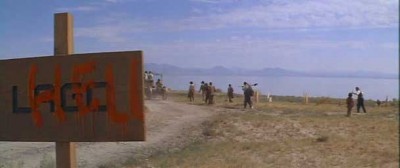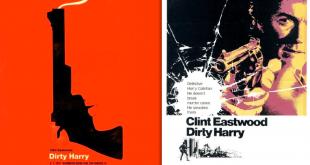 SYNOPSIS:
SYNOPSIS:
“A stranger rides out of the hot desert into a small town in the wild west. The townspeople are scared of him, and three gunmen unsuccessfully try to kill him. He takes a room and decides to stay. Meanwhile, a group of outlaws are about to return to the town and take their revenge – will the town’s leaders convince the mysterious man to help?” (courtesy IMDB)
REVIEW:
How was anyone to know that Clint Eastwood, who got his start playing weedy, virtually invisible bit parts in genre films such as Tarantula (1955), Revenge Of The Creature (1955) and Francis The Mule Joins The Navy (1955), would become one of the most respected filmmakers in cinema history? Clint directed and starred in this unusual western that was inspired by the tragic death of Kitty Genovese, who was brutally murdered in New York while her neighbours closed their windows, locked their doors and turned off their lights. Clint’s first foray into the genre as a director is a blackly comedic biblical tale about a nameless stranger who materialises seemingly out of no where, causes havoc in a small town, and then vanishes into the horizon.
 Clint plays the mysterious stranger who rides into a town whose entire population did nothing while three villains killed their marshal. Upon his arrival, he is immediately threatened by cowards, who make a couple of clumsy attempts on his life. Quickly coming to the realisation that the stranger is an excellent gunfighter, the town’s elders offer him money to protect them from the three villains who are on their way back from prison with a reckoning on their minds. Not content with the handsome purse on offer, the stranger barters with the town elders to gain full control of the fickle community. The stranger proceeds to take the town over, even painting it a hellish red. He promotes the town midget (Billy Curtis) to Sheriff, he rapes one woman (a prostitute), seduces another, and kills townspeople who protest his actions. When the villains return, he reveals another surprise. It may not be the most subtle way to incorporate Dionysian ideas into a western, but it’s certainly a visual spectacle to behold, especially when it burns and, by the final act, everything is set to go up in smoke.
Clint plays the mysterious stranger who rides into a town whose entire population did nothing while three villains killed their marshal. Upon his arrival, he is immediately threatened by cowards, who make a couple of clumsy attempts on his life. Quickly coming to the realisation that the stranger is an excellent gunfighter, the town’s elders offer him money to protect them from the three villains who are on their way back from prison with a reckoning on their minds. Not content with the handsome purse on offer, the stranger barters with the town elders to gain full control of the fickle community. The stranger proceeds to take the town over, even painting it a hellish red. He promotes the town midget (Billy Curtis) to Sheriff, he rapes one woman (a prostitute), seduces another, and kills townspeople who protest his actions. When the villains return, he reveals another surprise. It may not be the most subtle way to incorporate Dionysian ideas into a western, but it’s certainly a visual spectacle to behold, especially when it burns and, by the final act, everything is set to go up in smoke.
 At a time when the western looked to be in danger of nearing its end, High Plains Drifter (1973) approaches the pulp subject matter in the stylish mode of a horror film: Eerie atmosphere, choral music, apocalyptic visuals and overstated symbolism, all of which indicate that our hero is a wandering incarnation of the undead trapped in a state of purgatory. Indeed, the town of Lago (an abbreviation of Long Ago) is located on the edge of a barren wasteland that offers nothing more than the stranger, a vision of doom who rides into this ghostly town like some survivor of a far-off war or famine. A well-directed, exciting, oddly amusing film that is interesting in terms of how we respond to Clint’s character. He is, in effect, a ruthless avenging angel dealing out retribution for a wrathful god. His only good quality (for want of a better term) is that he sends a lot of sinners to hell early.
At a time when the western looked to be in danger of nearing its end, High Plains Drifter (1973) approaches the pulp subject matter in the stylish mode of a horror film: Eerie atmosphere, choral music, apocalyptic visuals and overstated symbolism, all of which indicate that our hero is a wandering incarnation of the undead trapped in a state of purgatory. Indeed, the town of Lago (an abbreviation of Long Ago) is located on the edge of a barren wasteland that offers nothing more than the stranger, a vision of doom who rides into this ghostly town like some survivor of a far-off war or famine. A well-directed, exciting, oddly amusing film that is interesting in terms of how we respond to Clint’s character. He is, in effect, a ruthless avenging angel dealing out retribution for a wrathful god. His only good quality (for want of a better term) is that he sends a lot of sinners to hell early.
 Screenwriter Ernest Tidyman is best known for his novels featuring the African-American detective John Shaft (1971) and his screenplay for the film version, which made him one of the few white people to win an NAACP Image Award. His screenplay for The French Connection (1971) won him an Oscar for Best Adapted Screenplay as well as an Edgar, a Golden Globe, and a Writers Guild Of America award. Tidyman also wrote the sequel to Shaft, Shaft’s Big Score (1972). In 1974 he published Dummy, a non-fiction novel concerning a deaf-mute accused of murder, and he co-wrote the script for A Force Of One (1979) for Chuck Norris – because nobody says ‘no’ to Chuck. Thereafter, Ernest never attained the kind of success he enjoyed with The French Connection and the Shaft series, although he had a high note with his teleplay for the made-for-television movie Guyana Tragedy: The Story Of Jim Jones (1980) which garnered him an Emmy award before sadly passing away in 1984.
Screenwriter Ernest Tidyman is best known for his novels featuring the African-American detective John Shaft (1971) and his screenplay for the film version, which made him one of the few white people to win an NAACP Image Award. His screenplay for The French Connection (1971) won him an Oscar for Best Adapted Screenplay as well as an Edgar, a Golden Globe, and a Writers Guild Of America award. Tidyman also wrote the sequel to Shaft, Shaft’s Big Score (1972). In 1974 he published Dummy, a non-fiction novel concerning a deaf-mute accused of murder, and he co-wrote the script for A Force Of One (1979) for Chuck Norris – because nobody says ‘no’ to Chuck. Thereafter, Ernest never attained the kind of success he enjoyed with The French Connection and the Shaft series, although he had a high note with his teleplay for the made-for-television movie Guyana Tragedy: The Story Of Jim Jones (1980) which garnered him an Emmy award before sadly passing away in 1984.
 Like a distant cousin to existential westerns such as The Shooting (1967), El Topo (1970), Zachariah (1971) and Dead Man (1995), High Plains Drifter embraces a bizarre yet satisfying supernatural bent, achieved with flashbacks depicting the brutal persecution of a mysterious man. In narrative terms, these nightmarish visuals serve to clarify the hidden motives of the stranger, while paradoxically unsettling the film’s carefully controlled surface reality.
Like a distant cousin to existential westerns such as The Shooting (1967), El Topo (1970), Zachariah (1971) and Dead Man (1995), High Plains Drifter embraces a bizarre yet satisfying supernatural bent, achieved with flashbacks depicting the brutal persecution of a mysterious man. In narrative terms, these nightmarish visuals serve to clarify the hidden motives of the stranger, while paradoxically unsettling the film’s carefully controlled surface reality.
 In fact, Clint’s career has often been scrutinised by conservative critics unable to recognise the subtleties inherent in his sly sense of humour. High Plains Drifter contains numerous delightful details, such as the tombstones named for Clint’s film-making mentors, Sergio Leone and Don Siegel, which just goes to show there is more than one ghost at work in the wildly symbolic spaces of this fine film. Having demonstrated to you the perils of probing the depths of the Existential Western genre, I’ll vanish into the horizon, after first inviting you to rendezvous with me at the same time next week when I present another dubious treasure for…Horror News! Toodles!
In fact, Clint’s career has often been scrutinised by conservative critics unable to recognise the subtleties inherent in his sly sense of humour. High Plains Drifter contains numerous delightful details, such as the tombstones named for Clint’s film-making mentors, Sergio Leone and Don Siegel, which just goes to show there is more than one ghost at work in the wildly symbolic spaces of this fine film. Having demonstrated to you the perils of probing the depths of the Existential Western genre, I’ll vanish into the horizon, after first inviting you to rendezvous with me at the same time next week when I present another dubious treasure for…Horror News! Toodles!
 Horror News | HNN Official Site | Horror Movies,Trailers, Reviews
Horror News | HNN Official Site | Horror Movies,Trailers, Reviews



